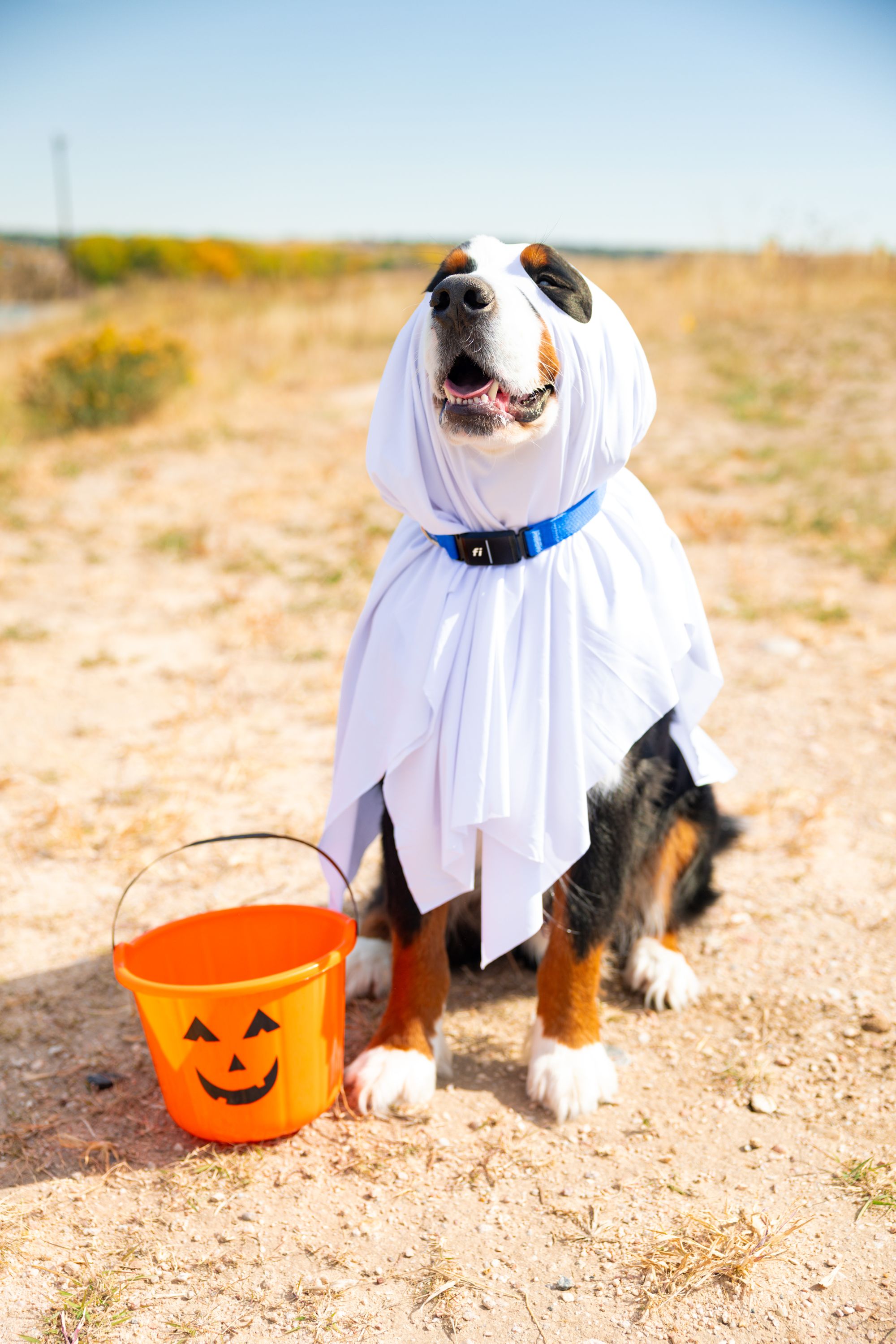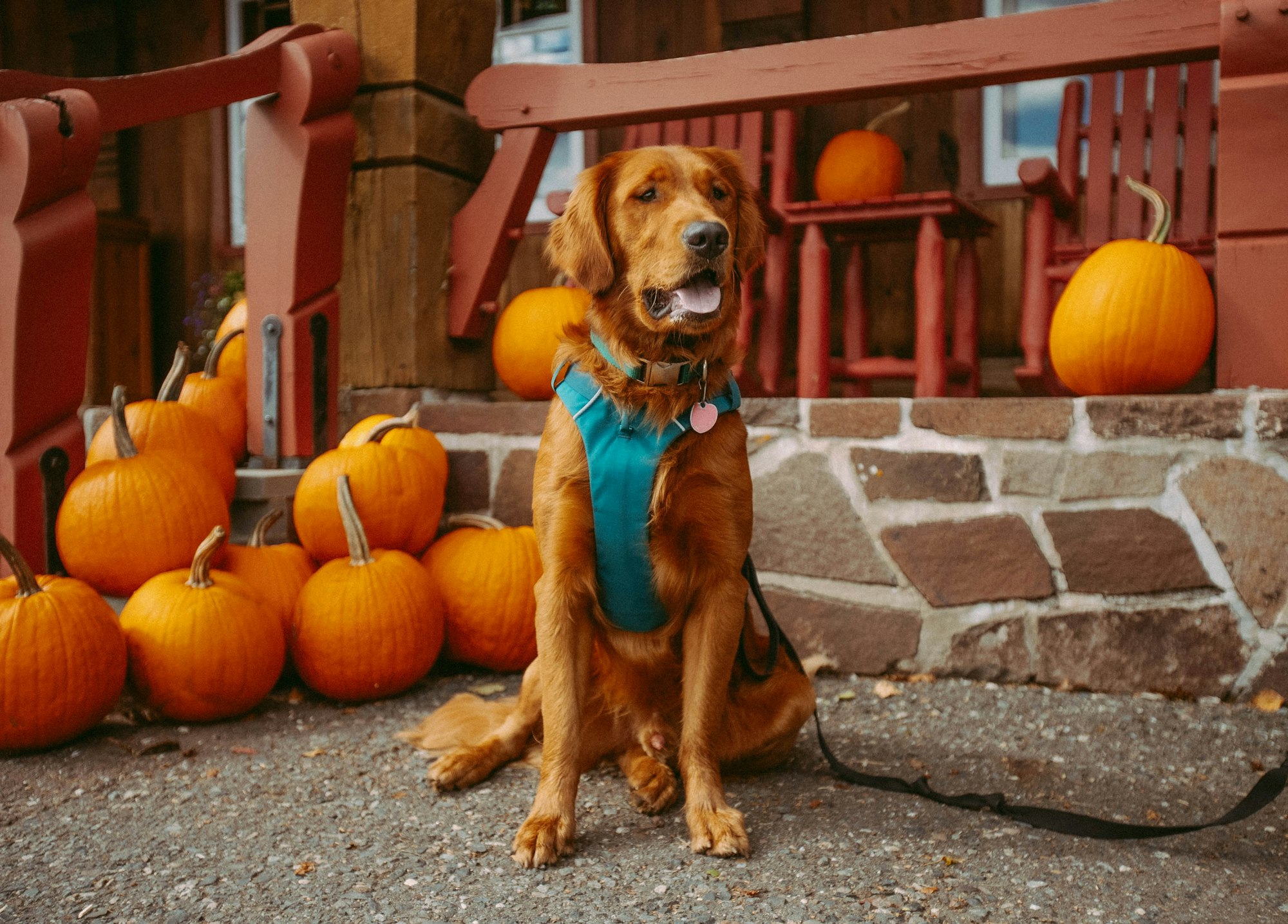Most families look forward to Halloween even before the pumpkin spice latte, and festive decorations announce the holiday is near. Kids of all ages love to go out trick or treating, and we enjoy seeing the eager faces appear at our own doors. Your pets, however...not so much. Whether it’s the costumes we humiliate them with, or the treats they can see but may not touch, it hardly qualifies as a holiday as far as Fido is concerned. And that ringing doorbell, are you serious? Again!?
Here’s some advice to help make Halloween more tolerable to your four legged kids, and less stress for you too.

1. Trick-or-Treat Candy Is Not For Pets.
Candy is meant to attract, and it does. Candy isn't good for dogs, and can actually be deadly. Still, dogs will happily eat what ever candy they can get their paws on. And because they can't unwrap it, they'll gobble up the wrapper too.
Chocolate -- but most especially baking or dark chocolate -- can be dangerous, even lethal, for dogs and cats. Symptoms of chocolate poisoning may include vomiting, diarrhea, rapid breathing, increased heart rate, and seizures. Fatty chocolate and candies can also predispose dogs to pancreatitis. Raisins can cause death, and many nuts are also dangerous if ingested.
If your dog snatches a candy or two, depending on the size, it's probably not cause for alarm, but if s/he gets into a big bag, s/he may end up in the hospital.
Halloween candies containing the artificial sweetener xylitol can also be poisonous to dogs. Even small amounts of xylitol can cause a sudden drop in blood sugar and subsequent loss of coordination and seizures. And while xylitol toxicity in cats has yet to be established, it's better to be safe than sorry.
And the wrappers, string, sticks that accompanied the candy may cause a blockage that requires medical attention.
2. Don't Leave Pets Out in the Yard on Halloween.
Surprisingly, vicious pranksters have been known to tease, injure, steal, and even kill pets on Halloween night. Keep yours safe in the house.
3. Keep Pets Confined and Away From the Door.
Remember to see it from your pet’s point of view: people, strange people, will be coming to the house on a semi continuous basis. There’s that continuously ringing of doorbell. The door opening and closing often. Small beings dressed in unusual costumes with masks.
Streams of visitors and associated noise can be stressful and confusing to a dog; his or her protective instinct is over-triggered; costumes may freak out a dog. Reactive behaviors could range from fear, anxiety, aggression, escape attempts, which are likely to be successful due to the frequently opening door.
If you know your dog is nervous, keep him or her contained in a part of the house that's as far as possible from the action. Even a normally calm dog may be overwhelmed by the activity and prefer to be contained in a secure environment. This also prevents your dog from getting out.
There are calming formulas, (such as Pro Sense's) which are herbal, natural formulas and which can help to keep your dog relaxed in this type of stressful situation.
And if you are tempted to take your dog along with your family as you "trick or treat," please be aware that these same considerations apply (noise, crowds, costumed kids).
4. Keep Halloween Plants, Such as Pumpkins and Corn, Out of Reach.
Although they are relatively nontoxic, such plants can induce gastrointestinal upset if ingested by your pet in large quantities. Intestinal blockage can even occur if large pieces are swallowed.

5. Don't Keep Lit Pumpkins Around Pets.
Should they get too close, they run the risk of burning themselves or knocking it over and causing a fire. As an alternative, consider battery operated or electric candles.
6. Keep Wires, Electric Lights, and Cords Out of Reach.
If chewed, your pet could cut himself or herself on shards of glass or plastic, or receive a possibly life-threatening electrical shock. I recommend using lights that run on a 12 volt transformer, in case you have a pet that likes chewing on electrical cords.
7. Don't Dress Your Pet in a Costume Unless You Know They'll Love It.
If you do decide that Fido or Kitty needs a costume, make sure it isn't annoying or unsafe. It should not constrict movement, hearing, or the ability to breathe or bark and meow.
8. Try on Pet Costumes Before the Big Night.
If they seem distressed, allergic, or show abnormal behavior, consider letting them go in their “birthday suit”. Festive bandanas usually work for party poopers, too.
9. IDs, Please!
If your dog or cat should escape and become lost, having the proper identification will increase the chances that they will be returned. Just make sure the information is up-to-date, even if your pet does have one of those embedded microchips.
And of course, charge up your Fi for the big night, and don't forget to turn on the LED light for your nighttime trick or treating!
Wishing you and your pets a fun, safe, Halloween!!
Jeff Werber, D.V.M.
Fi Veterinary Consultant






